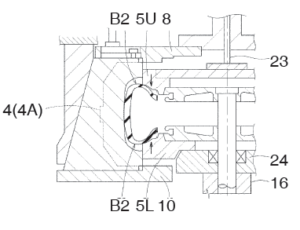Patents for May
Patents from United States Patent Office
Elastomeric proteins
U.S. patent: 10,988,515
Issued: April 27, 2021
Inventors: Joshua Kittleson, Michael Lee, David N. Breslauer and Daniel M. Widmaier
Assigned: Bolt Threads
Key statement: This invention relates to elastomeric protein and elastomeric protein production. In particular, the invention is directed to elastomeric protein sequences, including methods and compositions for production of elastomeric protein sequences, such as expression constructs, and host cells, and including compositions generated from the elastomeric protein sequences.
Inter-penetrating elastomer network derived from ground tire rubber particles
U.S. patent: 10,982,096
Issued: April 20, 2021
Inventor: William B. Coe
Key statement: Crumb rubber obtained from recycled tires is subjected to an interlinked substitution process. The process utilizes a reactive component that interferes with sulfur bonds. The resulting treated rubber exhibits properties similar to those of the virgin composite rubber structure prior to being granulated and is suitable for use in fabricating new tires, engineered rubber articles and asphalt rubber for use in waterproofing and paving applications.
Rubber compositions containing tackifiers
U.S. patent: 10,982,087
Issued: April 20, 2021
Inventors: Ashok T. Reddy, Craig Zirkle and Justyne Willman
Assigned: Hexion
Key statement: A composition comprising a rubber component selected from the group consisting of a rubber polymer, a synthetic rubber polymer and combinations thereof; and an alkylphenol resin which is a reaction product of at least one phenolic monomer selected from the group consisting of phenol, cresol, resorcinol, xylenol, ethyl phenol, alkylresorcinols and combinations thereof; and at least one alkyl aldehyde having from 5 to 12 carbon atom alkyl groups, is disclosed. The composition can be used to prepare articles of manufacture such as tires, tire treads, tire shoulders, tire sidewalls, rubber belts and rubber hoses.
Rubber crosslinked product
U.S. patent: 10,968,335
Issued: April 6, 2021
Inventors: Eijun Ueda, Misako Asada and Hidenori Yamagishi
Assigned: Zeon
Key statement: A crosslinked rubber obtained by crosslinking a rubber composition containing a conjugated diene rubber and an inorganic filler, wherein when a loss tangent value of a noninterface component forming, of the crosslinked rubber ingredient, a portion other than an interface with the inorganic filler is represented as L(m) and a loss tangent value of an interface component forming, of the crosslinked rubber ingredient, an interface portion with the inorganic filler is represented as L(i), each loss tangent value being measured using an atomic force microscope in a state in which sinusoidal vibrations of 5 kHz are applied to the crosslinked rubber, the crosslinked rubber has a ratio L(i)/ L(m) of 0.85 or less.
Sulfur-crosslinkable rubber mixture and vehicle tire
U.S. patent: 10,975,231
Issued: April 13, 2021
Inventors: Cornelia Schmaunz-Hirsch, Julia Schoeffel, Carla Recker, Kirsten Schwekendiek, Thomas Kramer and Katharina Herzog
Assigned: Evonik
Key statement: The invention relates to a sulfur-crosslinkable rubber mixture, in particular for rubber-coating reinforcements in elastomer products, especially in vehicle tires, or inner components of vehicle tires, as well as to a vehicle tire. The rubber mixture comprises a diene rubber, an adhesive system, 10 to 200 phr silica and 2 to 20 phr of a silane of the formula [(R1)3Si–X] mSn(R2)2-m, where residues R1 are identical or different alkoxy groups, cyclic dialkoxy groups, cycloalkoxy groups, phenoxy groups, aryl groups, alkyl groups, alkenyl groups, aralkyl groups or halides, and where X is a polar organic group containing urea, m represents the value 1 or 2, n is an integer between 1 and 8, and R2 is a hydrogen atom or an acyl group comprising 1 to 20 carbon atoms.
Rubber composition for tire tread and tire manufactured using same
U.S. patent: 10,982,076
Issued: April 20, 2021
Inventors: Ji HyunPark and Ki Hyun Kim
5/19/2021 Rubber World May 2021
digital.ipcprintservices.com/publication/?m=9911&i=707955&p=18&pre=1 3/3
Assigned: Hankook Tire
Key statement: The present disclosure relates to a rubber composition for a tire tread, the rubber composition comprising 100 parts by weight of a raw material rubber, 10 to 30 parts by weight of a vegetable oil having a weight ratio of linolenic acid to oleic acid of 1:0.5 to 1:1.5, 10 to 20 parts by weight of a terpene-based resin having a softening point of 110 to 130°C and 75 to 120 parts by weight of a reinforcing filler and a tire manufactured using the rubber composition for the tire tread. The present disclosure provides a tread rubber composition for four seasons which improves the braking performance on the ice and snow road surface and the abrasion resistant performance and improves the braking performance on the wet road surface at the same time while minimizing a drop in rotational resistance.
Tire vulcanizing method and tire vulcanizing apparatus
U.S. patent: 10,981,344
Issued: April 20, 2021
Inventor: Koji Otani
Assigned: Sumitomo Rubber
Key statement: A tire vulcanizing method includes a tire removal step for removing a vulcanized tire from a mold. The tire removal step includes a stage in which upper and lower side molds are moved inward in a tire axial direction so as to deform the vulcanized tire in a direction in which a bead width of the vulcanized tire is decreased and a stage in which, in the deformed state of the vulcanized tire, the segments are moved outward in a tire radial direction so that the segments are removed from the vulcanized tire.
Tire with laminate and method of making same
U.S. patent: 10,967,678
Issued: April 6, 2021
Inventors: Kathleen A. Clemmer and John P. Rodak
Assigned: Bridgestone
Key statement: A method of laminating a vulcanized tire includes providing a vulcanized tire having a circumferential tread and a pair of sidewalls constructed of a base rubber. The method further includes cleaning the circumferential tread, providing a laminate, and forming a plurality of holes in the laminate. The method also includes applying the laminate to at least a portion of one of the circumferential tread and a sidewall of the vulcanized tire. The method further includes applying pressure to the laminate, thereby evacuating air between the laminate and the circumferential tread of the vulcanized tire and curing the laminate.

